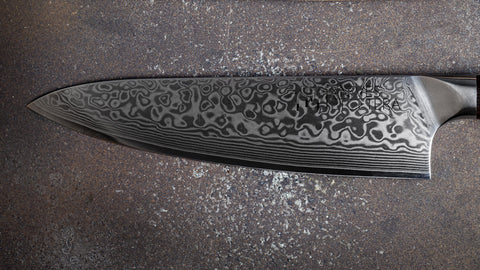Wondering if you’ve got your hands on a real Damascus knife or a fake? How do you really tell if a knife is real Damascus or not? Read on and we’ll outline how to put your mind at ease!
Damascus Steel Knives
In recent times, the popularity of Damascus steel knives have exploded throughout the Western world. Put simply, Damascus is easily identified as that aesthetically pleasing, wavy pattern that you’ve probably seen featured on a premium knife.
In effect, there are two ways to obtain Damascus steel - either with pattern-welded or Wootz steel.
Forging Wootz Steel
Wootz Steel originated in South India and is formed due to the clustering of Fe3C particles that occurs during the melting of low levels of carbide forming elements. It is thanks to this melting process, and the resulting carbonaceous matter, that this forging method delivers aesthetically pleasing patterns. The unique waving pattern is achieved when the material is forged into the wanted shape (such as a knife or sword) and this deliberate movement is precisely what gives the steel the wavy outcome.
This technique was handed down for centuries by blacksmiths across the Far East. It is thought that the makers of Wootz style Damascus largely died out during the 17th century and this is why recreating Damascus in the original Wootz style has largely been replaced by the Pattern-welded steel method.
Pattern-welded Steel
Today, the vast majority of Damascus steel products are forged using the pattern-welded steel method.
This process involves combining two (or more) types of steel together, where the types of steel selected complement each other. The different steels are heated and hammered until they mould together. Once this is done, the combined steel is folded, heated and hammered once more. This process is repeated until many layers (usually about 40) are formed. The final step in the formation process is to use acid etching to polish off the knives and make them more visible which also serves the added purpose of making the wavy patterns standout.
While this method utilizes less than 1% of carbon content, it is considered a superior method for making Damascus, compared to the Wootz method, due to the lack of impurities present.
HOW TO IDENTIFY REAL DAMASCUS FROM A FAKE
It is somewhat difficult to instantly identify the authenticity of a Damascus knife purely with the naked eye. Instead you need to use some elbow grease to address your concerns. It is a relatively straightforward process and will get you the answer you are looking for. To find out if your Damascus knife is real or fake just follow these steps:
- Polish a part of the blade thoroughly until the pattern is no longer visible.
- Soak the blade in an acid solution
One of two outcomes will occur:
- REAL: The pattern will re emerge after being submerged in the solution
- FAKE: The pattern will not re emerge and a randomly marked surface will be left
A common misconception is that a Damascus knife is only authentic if the pattern is visible everywhere across the blade. Some will state - if the pattern can not be seen across the blade, at the blade’s cutting edge, along the spine, and along the tang, then it is a fake.
This is not the case.
WHY IS THE PATTERN NOT VISIBLE EVERYWHERE?
Often authentic Damascus knives will not have the pattern visible all over the blade. There are two reasons for this.
- The pattern is not clearly visible because it has been polished out following etching from certain areas.
- The knife wasn’t acid etched and therefore the pattern does not cover the blade in its entirety.
MY KNIFE HAS BLACK RESIDUE WHEN I CLEAN IT -WHAT IS THIS?
Do not despair. Sometimes during the cleaning process you may witness a black residue coming off the blade. Your first thought might be that the pattern print is coming off with each scrubbing motion. This is likely not the case.
A more likely reason is that the residue you are seeing is a result of the acid etching. Seeing this black residue is not a sign that the knife you have is a fake Damascus blade.
WRAPPING UP
Damascus Knives are one of the most visually pleasing kitchen products you will own. They come in a vast range of sizes, styles and prices and it is for this reason that people often question the authenticity of the Damascus knife that they possess. But is your knife a fake?
To sum up:
Both Wootz steel and pattern-welding Damascus knives are authentic although you are more likely to have purchased a knife made with the pattern-welding method. Just because the pattern on the knife does not extend across the entire blade, does not mean that the knife is a fake. To identify the knife’s legitimacy simply scrub the blade thoroughly until the pattern disappears and then immerse it in an acid solution.
If the pattern returns, then rest assured, you have yourself a Damascus knife!
